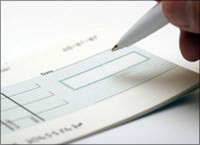 Earlier this month there was some newspaper reports about how a reputed bank in Bengaluru identified fake demand drafts (DD), and alerted the police. In this case the bar codes in the fake DDs lacked magnetic ink and were not readable on the MICR and this along with other vital clues helped stop the fraud.
Earlier this month there was some newspaper reports about how a reputed bank in Bengaluru identified fake demand drafts (DD), and alerted the police. In this case the bar codes in the fake DDs lacked magnetic ink and were not readable on the MICR and this along with other vital clues helped stop the fraud.
So, in a way the MICR codes saved the day for the bank! However, this is not the only use of MICR! There are many more uses. But before that let us see what the MICR is all about! What does it comprise of? Most importantly how is it useful to you?
What is MICR?
Many of you would have seen the magnetic inks bar codes printed on the bottom of your bank's cheque leaves. These bar codes are known as MICR code, an abbreviation for 'Magnetic Ink Character Recognition'.
Actually, the MICR is the name given to the technology used in printing the code.
In the early 1980s the Reserve Bank of India introduced many new modes for safe and effective payments across the country. One such important mode introduced was the unique system of MICR based cheque clearing system.
Apart from being a security bar code to protect your transaction, the MICR code is also an indispensable part for online money transfers. Every bank branch is given a unique MICR code and this helps the RBI to identify the bank branch and speed up the clearing process.
What does it comprise?
The MICR code has nine digits in it with each three digits signifying some important information about the transaction and the bank. The first three digits in the MICR code represent the city code that is the city in which the bank branch is located.
In most cases it is in line with the PIN code of the postal addresses in India.
The next three digits stand for the bank code while the last three digits represent the bank branch code.
For example, if you have an account with State Bank of India (SBI) Mumbai (Central) then its nine digit MICR code will be 400002009 wherein:
400, the first three digits representing the city code for Mumbai;
002, the next three digits representing the bank code for SBI;
And 009, the last three digits representing the bank branch code for Andheri (West).
You can check the MICR codes of different banks and its branches by checking it out on the RBI website.
How does MICR help speed up the processing of cheques?
Unlike the manual clearing of cheques where there is a possibility of many human errors and subsequent delay in clearing, the MICR code on the cheque printed with a unique magnetic ink usually iron oxide has magnetic material present in it and thus makes it machine-readable and almost error proof!
Under this method the reading machine or a cheque sorting machine reads through a cheque when inserted and identifies the branch the cheque belongs to and activates the automation clearing process.
The MICR code is so clear and fine that the machine could read it even if the MICR code isn't visible due to other marks or stamps on it.
According to the Reserve Bank of India report (Payments in India: Vision 2009-2012), all bank branches will be enabled with MICR codes.
Also, the RBI intends to reduce paper-based clearing process by introducing MICR- Cheque Processing Centres that will process over 95 per cent of volume and value of cheques processed in the country.





